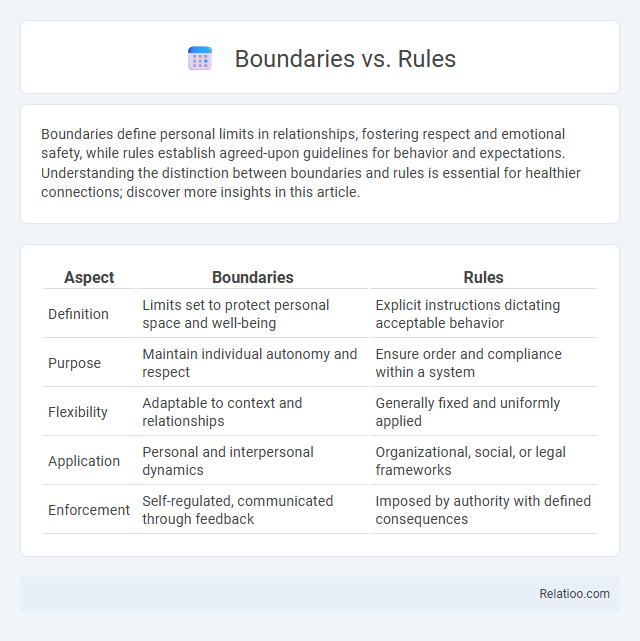Boundaries define personal limits in relationships, fostering respect and emotional safety, while rules establish agreed-upon guidelines for behavior and expectations. Understanding the distinction between boundaries and rules is essential for healthier connections; discover more insights in this article.
Table of Comparison
| Aspect | Boundaries | Rules |
|---|---|---|
| Definition | Limits set to protect personal space and well-being | Explicit instructions dictating acceptable behavior |
| Purpose | Maintain individual autonomy and respect | Ensure order and compliance within a system |
| Flexibility | Adaptable to context and relationships | Generally fixed and uniformly applied |
| Application | Personal and interpersonal dynamics | Organizational, social, or legal frameworks |
| Enforcement | Self-regulated, communicated through feedback | Imposed by authority with defined consequences |
Understanding the Difference: Boundaries vs Rules
Boundaries are personal limits that define what you find acceptable in relationships and interactions, reflecting your values and emotional needs. Rules are external guidelines or policies set to maintain order and consistency, often applied universally within a group or environment. Understanding the difference helps you communicate your personal boundaries clearly while navigating collective rules effectively for healthier connections.
Defining Boundaries in Relationships
Defining boundaries in relationships establishes clear limits that protect personal values, emotional well-being, and individual space. Boundaries differ from rules in that they are flexible guidelines reflecting personal comfort zones rather than rigid mandates, while reciprocity involves mutual respect and balanced give-and-take. Effective boundary setting fosters trust, prevents misunderstandings, and promotes healthy communication between partners.
What Are Rules and When Are They Needed?
Rules are explicit guidelines established to regulate behavior and ensure consistency within groups, organizations, or societies. They are needed in situations requiring clear expectations, safety, fairness, or order, such as workplaces, schools, or legal systems. Rules differ from boundaries by being externally imposed standards rather than personal limits and help facilitate predictable interactions and accountability.
The Psychology Behind Boundaries and Rules
Boundaries protect your emotional well-being by defining personal limits and promoting self-respect, while rules establish consistent guidelines for behavior within social or organizational contexts. The psychology behind boundaries emphasizes autonomy and individual needs, whereas rules often reflect collective expectations and social order. Reciprocity plays a crucial role by balancing personal boundaries with mutual respect and cooperation, ensuring healthy and functional relationships.
Setting Healthy Boundaries for Personal Growth
Setting healthy boundaries is essential for personal growth as it enables individuals to define their limits, protect their well-being, and foster self-respect. Unlike rigid rules, boundaries are flexible guidelines that promote mutual respect and understanding in relationships through clear communication and consistent enforcement. Reciprocity within boundaries ensures balanced exchanges, where giving and receiving align with personal values and emotional needs, supporting sustainable growth and authentic connections.
The Impact of Rules on Behavior and Freedom
Rules establish clear expectations that guide behavior, shaping your actions by defining acceptable and unacceptable conduct. While boundaries protect personal space and emotions, rules create a structured environment that can both limit and enhance freedom through predictability and order. Reciprocity fosters mutual respect, but rules specifically impact freedom by constraining choices to promote fairness and safety within a community.
Boundaries vs Rules in Parenting
Boundaries in parenting establish clear emotional and physical limits that protect a child's well-being and foster respect, whereas rules serve as specific guidelines outlining acceptable behaviors and consequences. You create boundaries to nurture trust and safety, ensuring your child understands personal space and emotional limits, while rules help maintain structure and consistency in daily routines. Effective parenting balances both by reinforcing boundaries that promote autonomy alongside rules that encourage responsibility.
Navigating Boundaries and Rules at Work
Navigating boundaries and rules at work requires understanding the distinction between personal limits and formal policies to maintain professionalism and respect. Clear communication of boundaries promotes a healthy workplace culture, while adherence to organizational rules safeguards compliance and productivity. Balancing reciprocity encourages mutual respect, fostering collaborative relationships that support team cohesion and individual well-being.
The Role of Communication in Establishing Boundaries and Rules
Effective communication plays a crucial role in establishing boundaries and rules by clearly expressing expectations, limits, and needs to prevent misunderstandings. Setting these parameters through open dialogue helps foster mutual respect and trust, ensuring that both parties understand and agree on acceptable behaviors. You strengthen relationships by actively listening and articulating your boundaries and rules with clarity, which promotes healthy reciprocity.
Choosing the Right Approach: Boundaries or Rules?
Choosing between boundaries and rules depends on the context and desired outcomes; boundaries emphasize personal limits and emotional well-being, while rules provide clear, external guidelines for behavior. Boundaries foster self-awareness and respect by defining what is acceptable for individuals, whereas rules establish uniform standards to maintain order and consistency within groups or systems. Effective application requires assessing whether the situation demands flexible, personalized limits or structured, enforceable directives to promote healthy interactions and accountability.

Infographic: Boundaries vs Rules
 relatioo.com
relatioo.com